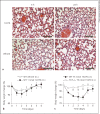Innate immune protection against infectious diseases by pulmonary administration of a phospholipid-conjugated TLR7 ligand
- PMID: 24192551
- PMCID: PMC3972367
- DOI: 10.1159/000355217
Innate immune protection against infectious diseases by pulmonary administration of a phospholipid-conjugated TLR7 ligand
Abstract
Pulmonary administration of Toll-like receptor (TLR) ligands protects hosts from inhaled pathogens. However, systemic side effects induced by TLR stimulation limit clinical development. Here, a small-molecule TLR7 ligand conjugated with phospholipid, 1V270 (also designated TMX201), was tested for innate immune activation and its ability to prevent pulmonary infection in mice. We hypothesized that phospholipid conjugation would increase internalization by immune cells and localize the compound in the lungs, thus avoiding side effects due to systemic cytokine release. Pulmonary 1V270 administration increased innate cytokines and chemokines in bronchial alveolar lavage fluids, but neither caused systemic induction of cytokines nor B cell proliferation in distant lymphoid organs. 1V270 activated pulmonary CD11c+ dendritic cells, which migrated to local lymph nodes. However, there was minimal cell infiltration into the pulmonary parenchyma. Prophylactic administration of 1V270 significantly protected mice from lethal infection with Bacillus anthracis, Venezuelan equine encephalitis virus and H1N1 influenza virus. The maximum tolerated dose of 1V270 by pulmonary administration was 75 times the effective therapeutic dose. Therefore, pulmonary 1V270 treatment can protect the host from different infectious agents by stimulating local innate immune responses while exhibiting an excellent safety profile.
© 2013 S. Karger AG, Basel.
Figures





Similar articles
-
Synthetic Toll-like receptor 4 (TLR4) and TLR7 ligands as influenza virus vaccine adjuvants induce rapid, sustained, and broadly protective responses.J Virol. 2015 Mar;89(6):3221-35. doi: 10.1128/JVI.03337-14. Epub 2015 Jan 7. J Virol. 2015. PMID: 25568203 Free PMC article.
-
Induction of oligoclonal CD8 T cell responses against pulmonary metastatic cancer by a phospholipid-conjugated TLR7 agonist.Proc Natl Acad Sci U S A. 2018 Jul 17;115(29):E6836-E6844. doi: 10.1073/pnas.1803281115. Epub 2018 Jul 2. Proc Natl Acad Sci U S A. 2018. PMID: 29967183 Free PMC article.
-
Synthetic Toll-Like Receptor 4 (TLR4) and TLR7 Ligands Work Additively via MyD88 To Induce Protective Antiviral Immunity in Mice.J Virol. 2017 Sep 12;91(19):e01050-17. doi: 10.1128/JVI.01050-17. Print 2017 Oct 1. J Virol. 2017. PMID: 28724768 Free PMC article.
-
A review of the interaction of Bacillus anthracis with cells of the innate immune response.Berl Munch Tierarztl Wochenschr. 2006 May-Jun;119(5-6):216-21. Berl Munch Tierarztl Wochenschr. 2006. PMID: 16729468 Review.
-
Targeting the "cytokine storm" for therapeutic benefit.Clin Vaccine Immunol. 2013 Mar;20(3):319-27. doi: 10.1128/CVI.00636-12. Epub 2013 Jan 2. Clin Vaccine Immunol. 2013. PMID: 23283640 Free PMC article. Review.
Cited by
-
The TLR7 agonist imiquimod induces anti-cancer effects via autophagic cell death and enhances anti-tumoral and systemic immunity during radiotherapy for melanoma.Oncotarget. 2017 Apr 11;8(15):24932-24948. doi: 10.18632/oncotarget.15326. Oncotarget. 2017. PMID: 28212561 Free PMC article.
-
Intranasal and epicutaneous administration of Toll-like receptor 7 (TLR7) agonists provides protection against influenza A virus-induced morbidity in mice.Sci Rep. 2019 Feb 20;9(1):2366. doi: 10.1038/s41598-019-38864-5. Sci Rep. 2019. PMID: 30787331 Free PMC article.
-
Evaluation of dual pathogen recognition receptor agonists as adjuvants for respiratory syncytial virus - virus-like particles for pulmonary delivery.Front Immunol. 2025 Mar 17;16:1561297. doi: 10.3389/fimmu.2025.1561297. eCollection 2025. Front Immunol. 2025. PMID: 40176816 Free PMC article.
-
Synthetic Toll-like receptor 4 (TLR4) and TLR7 ligands as influenza virus vaccine adjuvants induce rapid, sustained, and broadly protective responses.J Virol. 2015 Mar;89(6):3221-35. doi: 10.1128/JVI.03337-14. Epub 2015 Jan 7. J Virol. 2015. PMID: 25568203 Free PMC article.
-
Combination immunotherapy with TLR agonists and checkpoint inhibitors suppresses head and neck cancer.JCI Insight. 2017 Sep 21;2(18):e93397. doi: 10.1172/jci.insight.93397. eCollection 2017 Sep 21. JCI Insight. 2017. PMID: 28931759 Free PMC article.
References
-
- Williams AE, Edwards L, Humphreys IR, Snelgrove R, Rae A, Rappuoli R, Hussell T. Innate imprinting by the modified heat-labile toxin of Escherichia coli (LTK63) provides generic protection against lung infectious disease. J Immunol. 2004;173:7435–7443. - PubMed
-
- O'Neill LA, Golenbock D, Bowie AG. The history of Toll-like receptors - redefining innate immunity. Nat Rev Immunol. 2013;13:453–460. - PubMed
-
- Kawai T, Akira S. Toll-like receptors and their crosstalk with other innate receptors in infection and immunity. Immunity. 2011;34:637–650. - PubMed
-
- Hammerbeck DM, Burleson GR, Schuller CJ, Vasilakos JP, Tomai M, Egging E, Cochran FR, Woulfe S, Miller RL. Administration of a dual toll-like receptor 7 and toll-like receptor 8 agonist protects against influenza in rats. Antiviral Res. 2007;73:1–11. - PubMed
Publication types
MeSH terms
Substances
Grants and funding
LinkOut - more resources
Full Text Sources
Other Literature Sources
Medical
Research Materials

